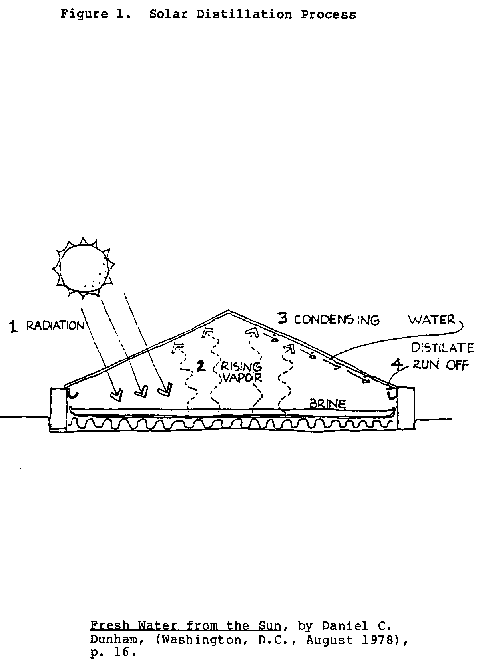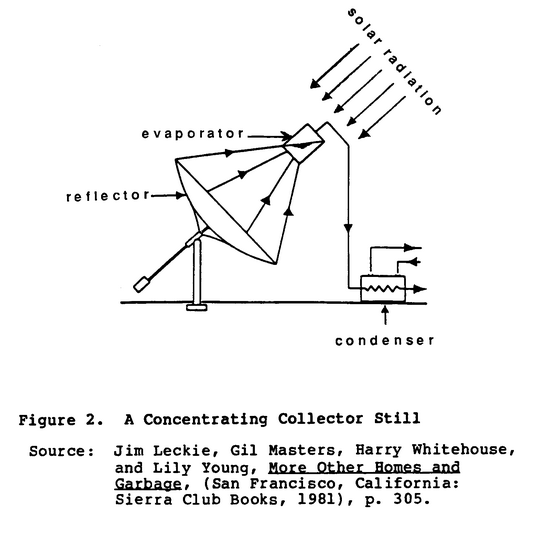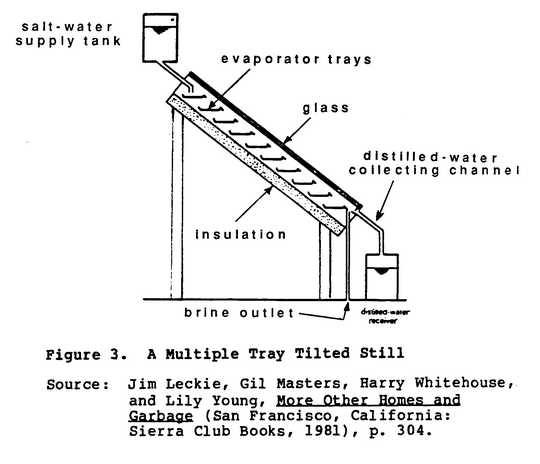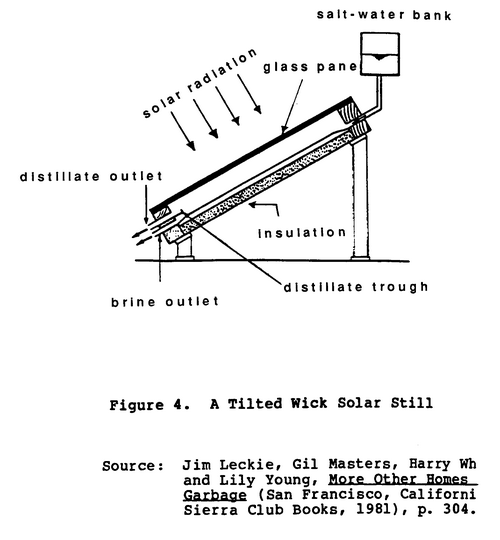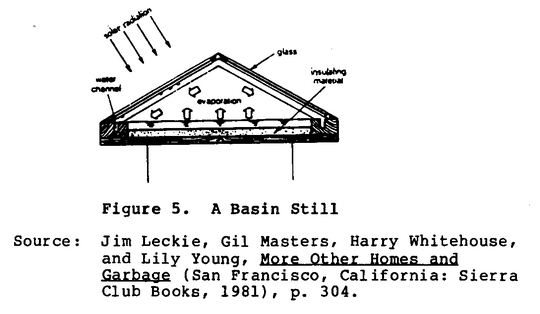NEEDS SERVED BY SOLAR DISTILLATION[edit | edit source]
Solar distillation could benefit developing countries in several ways:
- Solar distillation can be a cost-effective means of providing clean water for drinking, cooking, washing, and bathing--four basic human needs.
- It can improve health standards by removing impurities from questionable water supplies.
- It can help extend the usage of existing fresh water in locations where the quality or quantity of supply is deteriorating. Where sea water is available, it can reduce a developing country's dependence on rainfall.
- Solar stills, operating on sea or brackish water, can ensure supplies of water during a time of drought.
- Solar distillation generally uses less energy to purify water than other methods.
- It can foster cottage industries, animal husbandry, or hydroponics for food production in areas where such activities are now limited by inadequate supplies of pure water. Fishing could become important on desert seacoasts where no drinking water is available for fishermen.
- Solar distillation will permit settlement in sparsely-populated locations, thus relieving population pressures in urban areas.
APPLICATIONS[edit | edit source]
The energy from the sun used to distill water is free. But the cost of building a still makes the cost of the distilled water rather high, at least for large-scale uses such as agriculture and flushing away wastes in industry and homes. Consequently, the solar still is used principally to purify water for drinking and for some business, industry, laboratory, and green-house applications. It also appears able to purify polluted water.
Solar Distilled Water for Irrigation
For field agriculture, the solar still is not very promising. It takes about one meter depth of irrigation water per year to produce crops in dry climates, whereas the solar still can evaporate about two meters' depth. Thus, one square meter of solar still would irrigate two square meters of land. Unquestionably, the cost of building the still would make water more valuable than the crops being produced. This may not be true, however, for agriculture in controlled environments, i.e., greenhouses. A well-designed hydroponically-operated greenhouse should be able to produce 8 to 10 times as much food, per unit volume of water consumed, as field crops.
Recovery of Salt from a Solar Still
Since salt is a very cheap industrial material, and a solar still cannot produce anymore than an open pond, combining the recovery of salt with the distilling of water is not attractive economically. Where a family is using a solar still to provide water valued at $1 per day, the amount of salt they need might cost them half a cent.
Recovery of Potable Water from Sewage
Although it seems possible that potable water can be recovered from sewage, if contaminants such as odorous gases are present in sewage water fed to the still, some portion of those gases will evaporate and condense with the distilled water. In all probability they could be filtered out with activated carbon, but to date, however, no one has had any experience with this.
Alcohol Production
If the "contaminant" is alcohol, it can be separated from the water. But it would take two or three passes through the still to attain a high enough concentration of alcohol to be used as a fuel. Considering the current availability of fossil fuels, producing alcohol in this way is not yet economical. However, when fossil fuel supplies run low and the price rises, solar distillation could play a significant role.
Recovery of Distilled Water From Polluted Water Bodies
Whether or not solar distillation can actually purify polluted water is not yet known. Laboratory tests have shown, however, that a solar still can eliminate bacteria. If after additional research, a quantity of clean water can be recovered from polluted water, this capability may become economically more important than the purification of sea water. It may also be used to remove toxic substances such as pesticides.
Preliminary laboratory tests show that a modified version of the still--now commercially available--can do a very good job of removing such substances from feed water. Trichloroethylene (TCE), for example, has been removed by a factor of 5,000 to 1; ethylene dibromide (EDB) by 100 to 1; nitrates by 50 to 1; and others within those ranges. Of course, more work must be done to quantify these numbers, not to mention the unending list of chemicals that need to be tested.
Elimination of Algae. While algae will grow in some deep basin stills where the water temperature seldom gets very high, in the shallow basin still it is usually killed by the high temperature.
II. OPERATING PRINCIPLES[edit | edit source]
GENERAL THEORY OF SOLAR DISTILLATION[edit | edit source]
Distillation operates by the escape of moving molecules from the water surface into the gases above it. Sensible heat--the kind you can measure with a thermometer--is caused by the movement of molecules, zig-zagging about constantly, except that they are not all moving at the same speed. Add energy and they move faster, and the fastest-moving ones may escape the surface to become vapor.
It takes a lot of energy for water to vaporize. While a certain amount of energy is needed to raise the temperature of a kilogram of water from 0 [degrees] to 100 [degrees] Celsius (C), it takes five and one-half times that much to change it from water at 100 [degrees] C to water vapor at 100 [degrees] C. Practically all this energy, however, is given back when the water vapor condenses.
The salts and minerals do not evaporate along with the water. Ordinary table salt, for example, does not turn into vapor until it gets over 1400 [degrees] C, so it remains in the brine when the water evaporates. This is the way we get fresh water in the clouds from the oceans, by solar distillation. All the fresh water on earth has been solar distilled.
It is not necessary for the water to actually boil to bring about distillation. Steaming it away gently does the same job as boiling, except that in the solar still, it will usually turn out even more pure, because during boiling the breaking bubbles may contaminate the product water with tiny droplets of liquid water swept along with the vapor.
THE SOLAR DISTILLATION PROCESS[edit | edit source]
The solar distillation process is shown in Figure 1. Solar
(486x486)
energy passing through a glass cover heats up the brine or sea water in a pan; this causes the water to vaporize. The vapor then rises and condenses on the underside of the cover and runs down into distillate troughs.
Fresh Water from the Sun, by Daniel C. Dunham, (Washington, D.C., August 1978), p. 16.
A more technical description follows.:
- The sun's energy in the form of short electromagnetic waves passes through a clear glazing surface such as glass. Upon striking a darkened surface, this light changes wavelength, becoming long waves of heat which is added to the water in a shallow basin below the glazing. As the water heats up, it begins to evaporate.
- The warmed vapor rises to a cooler area. Almost all impurities are left behind in the basin.
- The vapor condenses onto the underside of the cooler glazing and accumulates into water droplets or sheets of water.
- The combination of gravity and the tilted glazing surface allows the water to run down the cover and into a collection trough, where it is channeled into storage.
In most units, less than half the calories of radiant energy falling on the still are used for the heat of vaporization necessary to produce the distilled water. A commercial stills are sold to date have had an efficiency range of 30 to 45 percent. (The maximum efficiency is just over 60 percent.) Efficiency is calculated in the following manner:
Efficiency = Energy required for the vaporization of the distillate that is recovered divided by the Energy in the sun's radiation that falls on the still.
Providing the costs don't rise significantly, an efficiency increase of a few percent is worth working for. Improvements are principally to be sought in materials and methods of construction.
SOLAR STILL DESIGN VARIATIONS[edit | edit source]
Although there are many designs for solar stills, and four general categories, (concentrating collector stills; multiple tray tilted stills; tilted wick solar stills; and basin stills) 95 percent of all functioning stills are of the basin type.
CONCENTRATING COLLECTOR STILL[edit | edit source]
A concentrating collector still, as shown in Figure 2, uses
(486x486)
parabolic mirrors to focus sunlight onto an enclosed evaporation vessel. This concentrated sunlight provides extremely high temperatures which are used to evaporate the contaminated water. The vapor is transported to a separate chamber where it condenses, and is transported to storage. This type of still is capable of producing from.5 to.6 gallons per day per square foot of reflector area. This type of output far surpasses other types of stills on a per square foot basis. Despite this still's outstanding performance, it has many drawbacks; including the high cost of building and maintaining it, the need for strong, direct sunlight, and its fragile nature.
MULTIPLE TRAY TILTED STILL[edit | edit source]
A multiple tray tilted still (Figure 3), consists of a series of
(486x486)
shallow horizontal black trays enclosed in an insulated container with a transparent top glazing cover. The vapor condenses onto the cover and flows down to the collection channel for eventual storage.
This still can be used in higher latitudes because the whole unit can be tilted to allow the sun's rays to strike perpendicular to the glazing surface. The tilt feature, however, is less important at and near the equator where there is less change in the sun's position over the still. Even though efficiencies of up to 50 percent have been measured, the practicality of this design remains doubtful due to:
- the complicated nature of construction involving many components;
- increased cost for multiple trays and mounting requirements.
TILTED WICK SOLAR STILL[edit | edit source]
A tilted wick solar still draws upon the capillary action of fibers to distribute feed water over the entire surface of the wick in a thin layer. The water is then exposed to sunlight. (See Figure 4.)
(486x486)
A tilted wick solar still allows a higher temperature to form on this thin layer than can be expected from a larger body of water. This system is as efficient as the tilted tray design, but its use in the field remains questionable because of:
- increased costs due to mounting requirements and essential insulation;
- the need to frequently clean the cloth wick of built-up sediments, highlighting the need for an operable glazing cover;
- the need to replace the black wick material on a regular basis due to sun bleaching and physical deterioration by ultra-violet radiation;
- uneven wetting of the wick which will result in dry spots, leading to reduced efficiency; and
- the unnecessary aspect of the tilt feature except where it is required higher latitudes.
BASIN STILL[edit | edit source]
A basin still (See Figure 5), is the most common type in use,
(540x540)
although not in current production.
While the basic design can take on many variations, the actual shape and concept have not changed substantially from the days of the Las Salinas, Chile stills built in 1872. The greatest changes have involved the use of new building materials, which may have the potential to lower overall costs while providing an acceptably long useful life and better performance.
All basin stills have four major components:
- a basin;
- a support structure;
- a transparent glazing cover; and
- a distillate trough (water channel).
In addition to these, ancillary components may include:
- insulation (usually under the basin);
- sealants;
- piping and valves;
- facilities for storage;
- an external cover to protect the other components from the weather and to make the still esthetically pleasing; and
- a reflector to concentrate sunlight.
Physical Dimensions of the Basin Still
The actual dimensions of basin stills vary greatly, depending on the availability of materials, water requirements, ownership patterns, and land location and availability.
If the only glazing available is one meter at its greatest dimension, the still's maximum inner width will be just under one meter. And the length of the still will be set according to what is needed to provide the amount of square meters to produce the required amount of water. Likewise, if an entire village were to own and use the still, the total installation would have to be quite large.
It is generally best to design an installation with many small modular units to supply the water. This allows:
- units to be added;
- manageable components to be handled by unskilled persons without expensive mechanical equipment;
- maintenance can be carried out on some units while others continue to operate.
Most community size stills 1/2 to 21/2 meters wide, with lengths ranging up to around 100 meters. Their lengths usually run along an eastwest axis to maximize the transmission of sunlight through the equatorialfacing sloped glass. Residential, appliance type units generally use glass about 0.65 to 0.9 meter wide with lengths ranging from two to three meters. A water depth of 1.5 to 2.5 cm is most common.
The usual argument for greater depths is that the stored heat can be used at night to enhance production when the air temperatures are lower. Unfortunately, no deep basin has ever attained the 43 percent efficiency typical of a still of minimum water depth. The results to date are clear: the shallower the depth the better. Of course, if the basin is too shallow, it will dry out and salts will be deposited, which is not good. Note that solar heat can evaporate about 0.5 cm of water on a clear day in summer. By setting the initial charge at about 1.5 cm depth, virtually all of the salts remain in the solution, and can be flushed out by the refilling operation.
